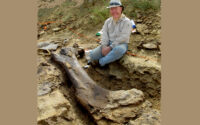“Jurassic Giants of Yorkshire and Wyoming”. Please note New date now 16th November!
- Date
- 16 Nov 2022
- Start time
- 2:30 PM
- Venue
- The Yorkshire Museum
- Speaker
- Professor Philip Manning, University of Manchester.

Jurassic Giants of Yorkshire and Wyoming
Professor Philip Manning, FGS, FRGS
Chair of Natural History
Director, Interdisciplinary Centre for Ancient Life
University of Manchester, UK.
Wyoming (USA) is approximately 4,400 miles away from the UK, but a paleontological past ties this fossil-rich region to the Yorkshire Coast. The Morrison Formation of Wyoming, dating between 156-147 million years old, is one of the richest windows on Late Jurassic life. It is in this formation that we see some of the largest animals to have ever walked on Earth, the long-necked and long-tailed sauropod dinosaurs. The evolutionary origins of these vast creatures has often been debated. The critical slice of geological time that might help answer such questions, the Middle Jurassic, is globally rare with little exposure to excavate sensible answers. However, one such place that offers insight to the Middle Jurassic is the Yorkshire Coast. From Cayton Bay to Staithes rocks of the Middle Jurassic (175-166 million years old) are exposed and provide fossil evidence on the dinosaurs that would later evolve to become the sauropod behemoths of the Morrison Formation. This talk will take you on a journey from the the Middle Jurassic Yorkshire Coast to the Upper Jurassic Badlands of Wyoming, and explain how geological time can help close the vast geographical distance between the UK and USA today.
Image: Philip Manning excavating a sauropod in the Morrison Formation of Wyoming in 2019.
Lecture to be held in the Tempest Anderson Lecture Theatre, Yorkshire Museum, YO1 7DR at 2.30pm ALL WELCOME.
Member’s report:
Professor Manning introduced himself as having been Curator of Geology at the Yorkshire Museum for about 20 years at the start of this century and noting the importance of the collection. The first Curator was John Phillips at the time of the Heroic Age of Geology 1800 – 1850 coinciding with the first naming of a dinosaur – Megalosaurus approx 200 years ago.
A critical slice of geological time is the Middle Jurassic (175 – 166 million years) which is globally rare but happens to be evident on the Yorkshire coast between Cayton Bay and Staithes. This area of coast was a source of alum, a mordant or dye fixer obtained by quarrying shale and processing it with urine. This quarrying was done mainly by hand and the miners would collect finds and sell them to collectors.
Professor Manning illustrated how we could currently tell where we are in the world by the creatures that we observe, with some very localised. This also applies to fossilised remains such as Tyrannosaurus Rex which is limited to a very small island. The factors affecting what survived and thrived included climate, physical barriers (mountains, oceans and deserts), distribution of resources and evolutionary history of organisms. Continental Drift also affected where organisms are found. New forms of dinosaur appeared in the Middle Jurassic period which evolved into those found in the Late Jurassic Period (156 – 147 million years) The fossils found on the Yorkshire Coast mainly consist of footprints with fossilised dinosaur bones being rare. One vertebra has been found which has been identified as a 25 metre Cetiosaur nicknamed ‘Alan’ after the finder and this can be linked to much larger dinosaurs in Wyoming 4,400 miles away. A second fossilised bone has recently been found on the Yorkshire Coast, younger than ‘Alan’ and expected to be of importance in the Middle Jurassic period.
The Yorkshire coast Middle Jurassic layer was formed close to the equator on a ‘greenhouse planet’ with no icecaps and no mountains. The Morrison Formation of Wyoming has a multitude of long necked long tailed Sauropods, preserved because it was on an extensive river system conducive to the preservation of land based skeletons whereas the Yorkshire Coast was not. Professor Manning has spent considerable time excavating complete skeletons in Wyoming but considers the 2 bones found on the Yorkshire coast as of more interest and importance on the evolution of dinosaurs.
Lively questions followed the talk.
Jon Coulson